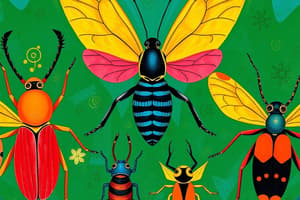Podcast
Questions and Answers
Which type of insect wing is characterized by a leathery or parchment-like base and a membranous tip?
Which type of insect wing is characterized by a leathery or parchment-like base and a membranous tip?
- Halteres
- Elytra
- Hemelytra (correct)
- Tegmina
What is the primary function of elytra in beetles?
What is the primary function of elytra in beetles?
- To assist in mating
- To aid in respiration
- To protect membranous hindwings (correct)
- To serve as a flight surface
Which structure is involved in the hearing mechanism of insects?
Which structure is involved in the hearing mechanism of insects?
- Ovipositor
- Cerci
- Tympanum (correct)
- Spiracles
Which type of insect wing is known for having soft, flexible characteristics and is often translucent or transparent?
Which type of insect wing is known for having soft, flexible characteristics and is often translucent or transparent?
What is the role of the cerci in the abdomen of certain insects?
What is the role of the cerci in the abdomen of certain insects?
Which type of insect legs are primarily adapted for jumping?
Which type of insect legs are primarily adapted for jumping?
What is the role of the tibia in insect locomotion?
What is the role of the tibia in insect locomotion?
Which structure is NOT part of the thorax in insects?
Which structure is NOT part of the thorax in insects?
Which of the following statements about insect wings is correct?
Which of the following statements about insect wings is correct?
What type of legs do aquatic insects typically have?
What type of legs do aquatic insects typically have?
Flashcards are hidden until you start studying
Study Notes
Insect Wings
- Elytra: Hardened front wings that protect membranous hindwings, found in beetles (Coleoptera)
- Hemelytra: Leathery wings at the base and membranous at the tip, characteristic of true bugs (Hemiptera)
- Tegmina: Completely leathery or parchment-like front wings, present in grasshoppers and mantises (Orthoptera)
- Haltere: Small, knob-like structures serving as gyroscopic organs for balance, found in flies (Diptera)
- Fringed Wings: Slender front and hindwings with long fringes of hair, typical of thrips (Thysanoptera)
- Membranous wings: Soft, flexible, transparent wings with prominent veins, present in bees, dragonflies, and damselflies (Hymenoptera, Odonata)
- Membranous wings with scales: Wings covered with powder-like scales, found in butterflies and moths (Lepidoptera)
Insect Abdomen
- Simple, anterior segments lack appendages
- Typically 10-11 segments
- Terga: Dorsal abdominal segments
- Sterna: Ventral segments
- Can expand for food storage and egg production
Abdomen Structures
- Spiracles: External openings of the trachea (respiratory tube)
- Tympanum: Hearing organ in insects
Abdomen Appendages
- Cerci: Sensory organs used in defense, propulsion, and copulation
- Cornicles: Found in aphids, secrete alarm pheromones
- Styli: Help to hold females during copulation
- Aedeagus: Penis of insects, male copulatory organ
- Ovipositor: Egg-laying apparatus of female insects, needle or blade-like
- Bursa Copulatrix: Reproductive organ of females
- Claspers: Used to hold the mate during copulation
Insect Thorax
- Responsible for locomotion (walking and flight)
- Composed of three segments:
- Prothorax: Bears the first pair of legs (prothoracic legs)
- Mesothorax: Bears a pair of legs and the first pair of wings (forewings)
- Metathorax: Bears a pair of legs and the second pair of wings (hindwings)
- Pterothorax: Fused mesothorax and metathorax
Thorax Structures
- Spiracle: Breathing organ
- Tympanum: Hearing organ
Thorax Appendages
- Legs:
- Coxa: Articulates with the thorax
- Trochanter: Freely movable segment connecting coxa and femur
- Femur: Largest and strongest segment, often modified for special functions
- Tibia: Long and slender, aids in locomotion and may bear spines
- Tarsus: Divided into tarsomeres (max 5), provides grip
- Pretarsus: Claw-like segments, aid in climbing and holding
Types of Insect Legs
- Ambulatory/Gressorial: Walking legs with normal segments
- Cursorial: Running legs with well-developed coxa
- Saltatorial: Jumping legs with enlarged femurs and elongated tibia
- Fossorial: Digging or burrowing legs with broad, flat, and dense coxa and femur
- Raptorial: Grasping legs with long coxa, enlarged femur, and spines
- Natatorial: Swimming legs with flattened femur and tibia, tarsi fringed with hairs
- Scansorial: Clinging legs with modified tarsi for holding
- Corbiculate: Foraging or pollen-gathering legs with a depressed area (pollen basket) and fringed hairs
Wings
- Organ of flight, also used for protection and balancing
- Veins:
- C: Costa
- Sc: Subcosta
- R: Radius
- Cu: Cubitus
- A: Anal
- J: Jugal
Types of Insect Wings
- Plumose: Segments with whorls of long hairs
- Lamellate: Nestled plates
- Aristate: Last segment enlarged with a bristle
- Stylate: Last segment bearing an elongated terminal finger-like process
Studying That Suits You
Use AI to generate personalized quizzes and flashcards to suit your learning preferences.




